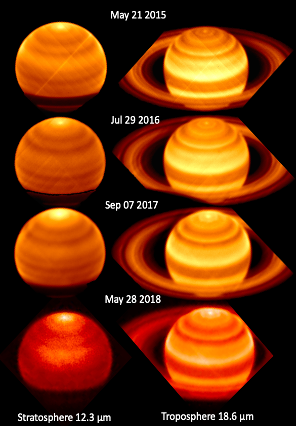- 1University of Leicester, Physics and Astronomy, Leicester, United Kingdom of Great Britain and Northern Ireland (jsdb3@le.ac.uk)
- 2L'Observatoire de Paris
- 3South West Research Institute
- 4Jet Propulsion Laboratory, NASA
Abstract
Observations from the Texas Echelon Cross Echelle Spectrograph (TEXES) on NASA’s IRTF and the VISIR instrument on the VLT are used to characterize the Saturn’s seasonal changes. Radiative transfer modelling (using NEMESIS [8]) provides the northern hemisphere temperature progression of the atmosphere over 10 years, both during and beyond the Cassini mission. Comparisons between imaging observations taken one Saturn year apart (1989-2018) show the extent of the interannual variability of Saturn’s northern hemisphere climate for the first time.
1. Introduction
With the culmination of Cassini's unprecedented 13-year exploration of the Saturn system in September 2017, and with no future missions currently scheduled to visit the ringed world, the requirement to build upon Cassini's discoveries now falls upon Earth-based observatories. Mid-infrared observations have been used to characterise features such as the extreme temperatures within an enormous storm system in 2011 [1,6], the cyclic variations in temperatures and winds associated with the 'Quasi-Periodic Oscillation' (QPO) in the equatorial stratosphere [2] and the onset of a seasonal warm polar vortex over the northern summer pole [3].
Saturn's axial tilt of 27º subjects its atmosphere to seasonal shifts in insolation [4], the effects of which are most significant at the gas giant's poles. The north pole emerged from northern spring equinox in 2009 (planetocentric solar longitude Ls=0º), and northern summer solstice in May 2017 (Ls=90º), providing Earth-based observers with their best visibility of the north polar region since 1987, with its warm central cyclone and long-lived hexagonal wave [5,6].
Studying these interconnected phenomena within Saturn's atmosphere (particularly those that evolve with time in a cyclic fashion) requires regular temporal sampling throughout Saturn's long 29.5-year orbit. We present here a showcase of research from the wealth of archived observations from both TEXES and VISIR obtained over the past decade.
1.1 Temperature progression
Methane (CH4) is used to determine stratospheric temperatures due to its even distribution across the planet, as well as its well understood emissive behavior. Figure 1 shows the visible changes in the stratospheric and tropospheric conditions as seen by VISIR over 3 years; these images are representative of a range of filters between 7-20 µm, which can be stacked and inverted to derive the 3D temperature distribution in the upper troposphere and stratosphere. Using this technique, we probe changes in the atmospheric 3D temperature distribution across the planet disc in VISIR observations taken from April 2008 (Ls=343º) to July 2018 (Ls=102º); thereby discerning the spatial variability as well as temporal. VISIR observations concurrent with the Cassini/CIRS observations will be used to cross-check the time-series from Cassini, which can be extended beyond the end-of-mission with the newer VISIR observations. These profiles will provide a new measure of long-term temperature variability in the context of an established model.
1.2 Interannual Variability
Spectroscopic maps of the northern summer hemisphere from TEXES instrument on the IRTF collected in September 2018 have provided a unique opportunity, as they were acquired exactly one Saturn year apart from the 1989 observations of Gezari et al, (1989) [7], which were the first ever 2D images of Saturn in the mid-IR. Examining the differences in brightness temperatures and composition will indicate the extent of any interannual variation for Saturn’s northern hemisphere. This study will also provide unique insight into the timescale of the QPO which will be contrasted with a previously suggested biennial cycle [2]. The seasonal temperature progression measured in Section 1.1 also enables us to place this interannual variability in a wider context and provides further opportunity for insightful comparison with the comparatively shorter-term temperature variability.

Figure 1: VISIR observations from P95-102 sensing the troposphere (right) and stratosphere (left). Polar warming is evident in the stratosphere; but is considerably smaller than that seen during southern summer and in the historical record of the 1980s. The warm polar hexagon is seen at the north pole, the first such observation from the ground. Work to remove residual striping is ongoing and has been successfully applied to the 2017 images. 2015-16 images have been published by Fletcher et al., 2017 [2].
Acknowledgements
This research is funded by a European Research Council consolidated grant under the European Union’s Horizon 2020 research and innovation program, grant agreement 723890. We would like to thank co-author Mael Es-Sayeh for his significant contribution to this research.
References
[1] Fletcher et al., 2012, Icarus 221, p560-586
[2] Fletcher et al., 2017, Nature Astronomy, 1, p765-770
[3] Fletcher et al. 2015, Icarus. 251, 131-153
[4] Fletcher et al., 2015, https://arxiv.org/abs/1510.05690
[5] Fletcher et al., 2008, Science. 319, 79-81
[6] Fouchet et al., 2016, Icarus, 277, p196-214
[7] Gezari et al., 1989, Nature, 342, 777–780
[8] Irwin et al. 2008, JQSRT 109:1136-1150
[9] Orton et al., 2008, Nature 453, p198
How to cite: Blake, J., Fletcher, L., Antunano, A., Melin, H., Roman, M., Es Sayeh, M., Donelly, P., Rowe-Gurney, N., King, O., Greathouse, T., and Orton, G.: Saturn’s Seasonal Atmosphere: Cassini CIRS contrasts to VLT and IRTF observations, Europlanet Science Congress 2020, online, 21 Sep–9 Oct 2020, EPSC2020-310, https://doi.org/10.5194/epsc2020-310, 2020.

